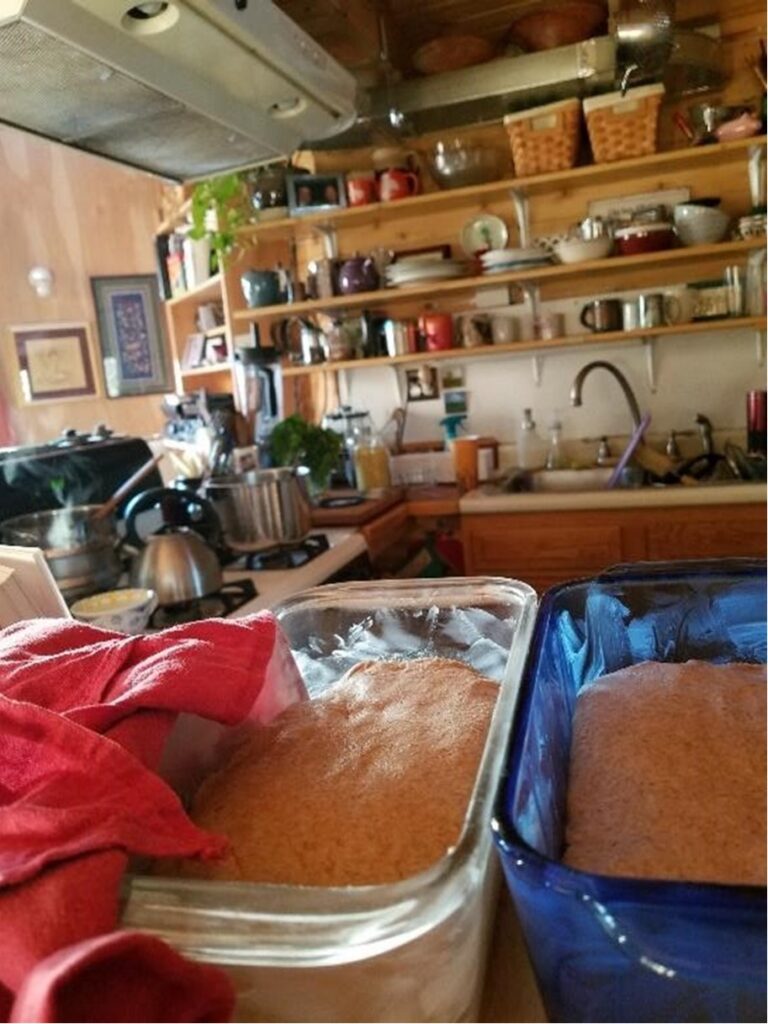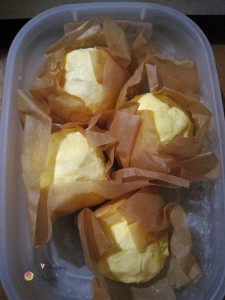Probiotic-Rich Cultured Butter
Tara Carpenter, NC.
Nutrition Consultant helping people heal with therapeutic nutrition.

Originally published on November 6, 2018.
I make cultured butter few times a year; mainly late summer to early autumn and late spring into early summer when I can easily source fresh, raw pastured cream. This raw cream gets turned into crème fraîche which I then churn into sturdy, golden mounds of delicious probiotic-rich butter “a.k.a. cultured butter” (beginner recipe below).
If you are prone to a dairy or fat sensitivity then you may find this butter to be easy-to-digest. The hardest part I find in making this recipe is sourcing full-fat cream (preferably raw) and culture starter. Cream from cows that graze on green grass in the sunshine contains significantly more essential fatty acids that can help your body lower inflammation levels.

I like to shape butter with my hands; wrapping each mound in a piece of parchment paper then placing some of them into a Ziploc bags in the freezer for the coming winter when the deep gold color is a beautiful sight for eyes surrounded by white snow. If you have kids offer them the fine-mesh strainer used to strain the fatty butter …. they love to suck the tiny butterfat remnants with glorious happy sounds. Music to a mama ears 🙂

Cultured Butter
Yields: ¼ lb. butter* and 1 cup buttermilk
Ingredients
1 pint grass-fed, full-fat cream (raw will give most flavor/enzyme activity)
1 packet of starter culture** OR 2 Tbs whey or buttermilk
Instructions
- Bring cream to room temp.
- Place in a clean glass jar.
- Whisk in culture starter.
- Cover and allow to sit for 12-20 hrs. at 72-75 degrees Fahrenheit.
- Refrigerate the slightly thick cream for 2-3 days (optional but allows cream to “set” which helps butter to churn faster).
- Remove from fridge and let it come to 55-65 degrees.
- Pour into a food processor with steel blade or a stand-mixer with a whisk, or a blender. You can also churn with an electric or hand-crank blender if you have one.
- Churn slowly at first, graduating to high speed, until butter forms (cream moves through 3 stages: whip cream, stiff whip cream, then splits into butter/buttermilk).
- Drain through fine-mesh sieve over a bowl to catch the buttermilk (save for later).
- Transfer butter to a small bowl, pressing out any remaining buttermilk with a spoon.
- Add cold water, wash the butter, and press until no more buttermilk is released.***
- Form butter into a ball and pat dry with a paper towel.
- Season with ¼-1/2 tsp fine ground sea salt, herbs, garlic or Herbamore (if desired).
- Wrap in wax paper, store in fridge (freeze for long-term storage).
Tips & Ideas
- Reserve a small amount of the thick cream each time to use as the starter in the next batch. Like a good sourdough, the flavor will continue to develop as time goes on.
- Make a bunch at once and freeze. I do this every year when the cream is at its richest from cows grazing all summer long. Making cultured butter is greasy business; I make a lot when I do.
- Don’t cook cultured butter because has live beneficial bacteria (probiotics) inside. Heat kills/destroys good flora.
- Butter and other fat (duck fat, pumpkin seed oil, coconut oil) is great for teeth, joints, and bones. Fat in general is a “carrier” and carries nutrients from food you eat deep into your cells.
*Actual amount of butter you get depends on fat content of the cream used. Holstein cows produce milk with the least amount of fat, while Jersey cows produce a fattier milk.
**I use Body Ecology culture starter with 6 packets per box, this high quality one as contains Lactobacillus plantarum, which research suggests may help gut dysbiosis, like IBS, Crohn’s Disease and Colitis.
***Butter that is washed tends to store longer than unwashed butter.
References
Campbell-McBride, N. MD. (2011). Gut and Psychology Syndrome. Soham, Cambridge; Medinform Publishing.
Gates, D. (2010). The Body Ecology Diet. Bogart, GA: B.E.D. Publications.
May all bellies be happy!
Disclaimer: This post may contain affiliate links for products I believe in and use on a regular basis. See more here. All content is general information only, primarily educational in nature, and not to be treated as a substitute for the medical advice of your primary health-care practitioner that you, the reader, may require for any cause whatsoever, now or in future. Consult your primary practitioner regarding any health problem(s) you have and keep them informed to opinions, ideas, and advice on this site you find useful. You can email tara@happybellies.net with any questions or concerns.
© Happy Bellies Therapeutic Nutrition blog is copyrighted information. Do not repost my recipe or post on your blog, Facebook, or other website. Posting ingredients and sharing my photos is permitted with a link back to my site for full recipe or post.


2 replies on “Probiotic-Rich Cultured Butter”
You just want to add in a bit of cold water to your churned ball of fat and knead it with your hands – this massages out remaining buttermilk and helps to make your butter last longer and have a more rich flavor.
How do you wash butter?